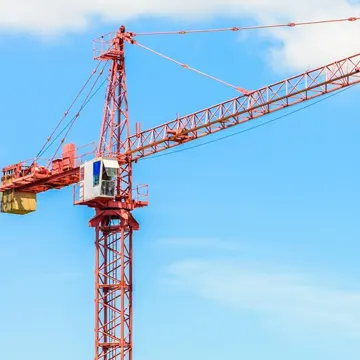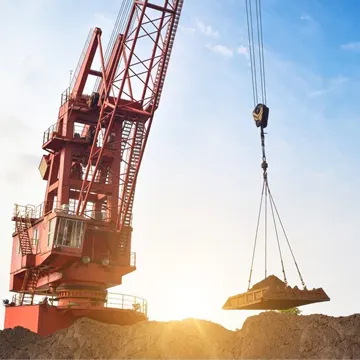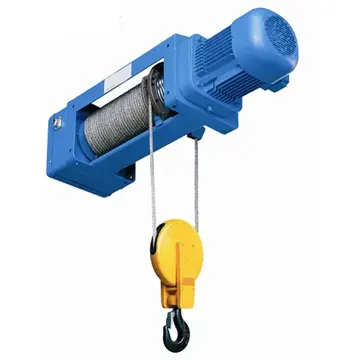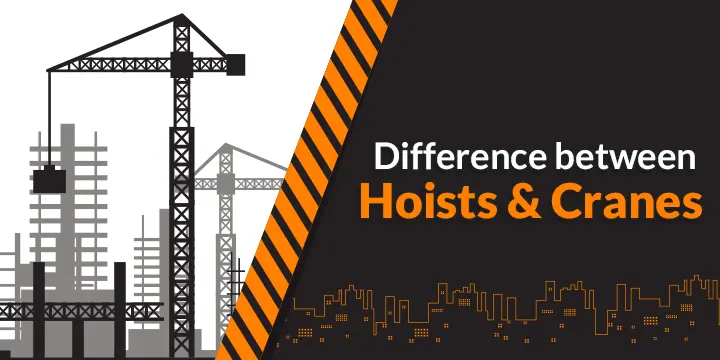Difference between hoists and cranes
Industrial and commercial job sites used to move or lift heavy material by using hoists or cranes.
Some people mistakenly use the terms interchangeably due to their similarities in function.
The Design and use may differ due to distinct machines, hoists move loads up and down and Cranes move loads up and down and side to side.
In this article, we’ll guide you through a complete overview of overhead cranes and hoists, Such as how they operate, how they lift weight, and the types of lifting equipment.
An Overview of Cranes

The Cranes is a piece of equipment that lifts heavy loads along a vertical axis and carries them along other axes. Cranes can do mobility in a worksite and we can access multi-direction. In particular, a site person can use a crane system to lift a load at one area of the site and move a load.
Parts of a Crane
Cranes consist of three main Parts :
Hoist
The hoist can control the vertical lifting and lowering and it is completely fixed with trolley parts. Apparently,that can move front and back as needed.
Note: Load capacity depends on its structure and construction.
Perhaps, chain hoists are just for loads of 5 tons and below, while wire rope hoists are suitable for loads of 5 tons and above.
Trolley
The trolley moves the hoist along the bridge and mainly it is available in three types but the advantages in various applications. Headroom trolleys like low-headroom trolleys feature a compact design that makes them fit for a crane with one-girder applications. Ordinary headroom trolleys are just for jib cranes and monorails.
Bridge
The bridge makes the trolley move back and forth.
Types of cranes

Mostly all cranes work under the same basic structured principles.
It is available in numerous variations that fit different work environments. These are the most common types.
Top running cranes
The bridge components move atop ceiling-mounted rails
in top-running cranes. This crane is well-designed for lifting and moving heavy loads.
Under-running cranes
Bridge components move along the bottom of ceiling-mounted rails in under-running cranes.
Gantry cranes
The bridge component is not attached to the ceiling in this crane so Rather a single or double girder is attached to wheeled legs. This crane design is popular in shipbuilding.
Monorail cranes
the trolley-mounted hoist moves along a straight, round, oval, or wide path in this crane.
Monorail cranes are specially designed for moving loads within tight or difficult spaces.
Hoists

Apart from cranes, hoists only deliver vertical direction which means direction and there is no horizontal moving direction to loads except when used as the lifting component of larger lifting systems.
Design Reviews for Hoists
Despite their restricted directional mobility, hoists are nonetheless widely utilized for lifting big items and equipment. The type used varies by use and depends on the lifting needs. Some of the design elements to consider are:
Lifting medium
The lifting medium is the material used to attach the load hook (the component that secures the load) to the body of the hoist. The kind employed in a hoist system is determined by the load(s)’ expected weight. It may be rope, metal cable, roller load chain, or welded link chain.
Power
This refers to how the hoist is powered. It can be a manual mechanism (for example, a pulley used to double the operator’s pulling force), or an electrical mechanism. The hoist system depends on the lifting and lowering force required and the existing facility.
Differences Between Overhead hoists and cranes .
There are numerous variations between overhead cranes and hoists. The biggest one is their range of motion. Hoists can only carry goods up and down, whereas cranes can move weights both up and down and sideways. In the latter, a hoist allows vertical mobility, whereas a trolley and bridge allow for horizontal movement.
The classification of overhead cranes and hoists is another significant distinction. Overhead cranes are often classed by their design and construction (e.g., top running, under running, gantry, and monorail), whereas hoists are defined by their lifting medium, power type, and suspension.
So this is the Difference between hoists and cranes for more info follow up on crane care.



